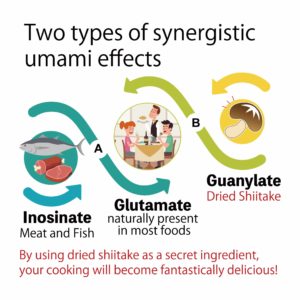
More and more of us around the world enjoy the delicious taste and texture of Shiitake mushrooms. However, please permit me to tell you a story about Dried Shiitake mushrooms which you might not know it well.
Cultivation approaches.
Most Shiitake are farmed using sawdust. However, the most delicious Shiitake are grown outdoors on real tree logs which are cultivated only twice a year in the spring and fall. Because of the seasonal nature of Fresh Shiitake, Dried Shiitake is the primary product in the Shiitake market.
Dried Shiitake is a unique and significant Umami booster.
The unique Umami characteristic of Dried Shiitake is Guanylate. This Umami component is created during the drying and rehydrating process, and not available in Fresh Shiitake.
See Umami-rich ingredients at http://www.umamiinfo.com/richfood/
Shiitake is a Japanese word.
From ancient times, Shiitake had been an essential export item from Japan to China. Chinese Dried Shiitake are usually farmed on fungal beds using sawdust. The most delicious Japanese Dried Shiitake are cultivated from real logs. The dried Shiitake from Kyushu (a Southern Island of Japan) farmed using Japanese Sweet Sap Oak (“kunugi” in Japanese) are recognized as the best. Kunugi logs give the Shiitake a distinctive sweet and deep flavor.
Because Japanese Shiitake is the best recognized by taste and name among the many similar Shiitake mushrooms from different countries, the Japanese word “Shiitake” is the globally accepted term for this type of mushroom.
Dried Shiitake: The Secret Umami booster.
Dried Shiitake contains the most significant amounts of Guanylate of any foods.
There are two ways to strengthen the Umami taste.
I) Glutamate x Inosinate
II) Glutamate x Guanylate
See: http://www.umamiinfo.lcom/richfood/
Meats and fish contains much Inosinate. However, Guanylate is missing in most foods, including Fresh Shiitake, but available in large amounts in Dried Shiitake. This type of Umami-rich synergy is less well known and can become your secret ingredient.
Adding Dried Shiitake makes all food even more delicious.
Since most food ingredients contain Glutamate, adding Dried Shiitake to dishes improves the Umami of all foods. Even by adding just a small amount of Dried Shiitake, will enhance and strengthen how you taste the Umami Flavors for all your dishes.
Tips for cooking with delicious Dried Shiitake.
Three tips.
1) Place the Dried Shiitake in a container filled with room temperature water and refrigerate. The should be enough water to submerge the dried Shiitake after it sinks to the bottom. Rehydrated Shiitake can keep for three days.
=>See https://www.shiitake.tips/use-rehydrate)
2) When gently boiling the Dried Shiitake, a white foam will appear. It is not scum, so do not remove. It will dissolve in the broth and further improve the taste.
3) Boil for 10 minutes until a strong smell fades away which will strengthen the Umami taste.
How to make a simple but good Dried Shiitake dish.
Shiitake Roasted in Foil
Wrap the Shiitake in foil with a 1/2 Tsp. of butter for each one whole rehydrated Shiitake.
Heat in a pan over medium heat until steam is visible coming out of the foiled package. Turn heat down to low and heat for another 3 minutes. Serve with soy sauce or salt.
How to use the Shiitake stem.
The abundant amount of Guanylate found in naturally grown Shiitake is also contained in the stem. Guanylate will intensify the Umami taste in Glutamate available in foods. So, you can use the stem as your secret Umami booster.
Using dried.
Twist stem away from the Shiitake cap. Put dried stems in stews, soups, braises, and so on. After cooking, remove stem before serving.
After rehydration.
Finely chop the stem and use in various ways such as adding to a salad dressing or to your salad itself, soups, sandwiches, etc. Please note: the chopped stems need to be cooked to soften and bring out the flavor before using.